A Stochastic User Equilibrium Model Under Traffic Rationing Based on Mode Shifting Rate
Abstract
1. Introduction
2. Equilibrium Model under Traffic Rationing
2.1. General Framework
- Point to point travel by private car with purchasing traffic tools: Travel time is equal to driving time on the road, without additional time. Travel cost includes the fixed cost for phrasing traffic mode and use cost related to travel time.
- Point to point travel by taxi with purchasing traffic services: This category includes traditional taxi, online taxi-hailing, time-sharing car rental and future autonomous taxi. Travel time is composed of driving time on the road and waiting time for services. Travel cost only includes the use cost related to travel time.
- Fixed route travel by bus with purchasing traffic services: This category includes various public modes with fixed stations and routes. Travel time is composed of driving time on the road, waiting time for services and access time such as time for “the last mile”. Travel cost is equal to fixed cost or use cost related to travel distance.
- Bus lines have sufficient operation capacity and high reliability of operation time, that is, travel time by bus is not affected by the quantity of passengers on the bus.
- There is only one bus line with fixed travel time and fixed unit time fare between each OD. Study on route selection only covers private car and taxi rather than bus.
- Traffic flow of bus is independent from traffic flow of private car and taxi.
- Each trip of private car or taxi only serves a single passenger.
- Carrying capacity of taxi is sufficient and efficiency of taxi dispatching keeps stable.
- Base network: represents directed strongly connected network, in which represents the set of nodes and represents the set of directed links for car. represents a directed link. is the set of bus route and represents one route between a specific OD.
- Travel demand: is the set of ODs and represents an OD. Travel demand is denoted as a vector , in which the number of rows is and represents the traffic demand between OD .
- Route selection: represents the set of alternative travel routes between OD . The strong connection of network can ensure . denotes an alternative travel route, and the set of whole alternative travel routes among all ODs is denoted as .
- Travel impedance: Travel impedance of links is denoted as a vector , in which the number of rows is equal to and represents the travel impedance of link . represents the function for calculating link impedance, represents the travel impedance of route and represents the minimum travel impedance between OD .
- Traffic assignment: Traffic flow on links is denoted as a vector , represents traffic flow on link generated from OD . represents the traffic flow of route .
- Matching relationship: Define link-route incidence matrix , whose elements are denoted as . If link is on route , ; else, . Define OD-route incidence matrix , whose elements are denoted as . For each OD , if , ; else, .
2.2. Mode Shifting Rate under Traffic Rationing
2.2.1. Calculation of Mode Shifting Rate
- (1)
- All the original travel routes are restricted and detour is needed for completing trips, as shown in Figure 2a. At this time, detour rate is greater than 1.00. Travelers decide whether to still travel by private car or shift to taxi and bus based on updated traffic consumption of private car, taxi and bus.
- (2)
- Only part of original travel routes are restricted, as shown in Figure 2b. The updated set of alternative travel route includes the remaining unrestricted travel routes and detour routes. The mode shifting rate is determined by detour rate. If detour rate is equal to 1.00, mode shift rate is . If detour rate is larger than 1.00, mode shift rate is calculated based on updated traffic consumption of private car, taxi and bus.
- (3)
- ll the original travel routes are not restricted, as shown in Figure 2c. At this time, detour rate is equal to 1.00 and there is no shift of traffic demand. That is, .
2.2.2. Calculation of Changed Traffic Demand Structure
2.3. General Travel Cost and Multimodal Path Sets under Traffic Rationing
2.3.1. Travel Consumption of Private Cars under Traffic Restriction
2.3.2. Travel Consumption of Taxis under Traffic Restriction
2.3.3. Travel Consumption of Buses under Traffic Restriction
2.3.4. Route Choice Model
2.4. Stochastic User Equilibrium Model
3. Solution Algorithm
- (1)
- OD classification: Original OD of private car is classified into restricted OD and unrestricted OD
- (2)
- Detour rate calculation: Travel time on links is calculated based on equilibrium flow before traffic restriction. Travel time on routes is further calculated based on alternative route sets . Referring to Equation (23), the expected minimum travel time and detour rate of OD are obtained.
- (3)
- Mode shifting rate calculation: Mode shifting rate is determined by Equations (1)–(6) based on set of alternative routes .
- (4)
- Traffic demand calculation: Solving the updated structure of traffic demand under traffic restriction based on Equations (7)–(11).
- (1)
- Flow initialization: Set iteration . Travel time and travel consumptions on routes are calculated based on given actual travel time on links under condition of free flow. Then, traffic demand is randomly assigned to network according to the estimated travel consumption and the initial set of link flow is obtained.
- (2)
- Travel time updating: Set iteration , updated travel time on links is calculated based on the function .
- (3)
- Descent direction solution: Travel time of route is updated based on updated travel time on links. Traffic demand is randomly assigned to network according to the estimated travel consumption. Consequently, the additional flow of link and descent direction are obtained.
- (4)
- Traffic flow updating: Traffic flow on links is updated based on the function .
- (5)
- Convergence judgement: If the convergence condition shown in Equation (33) is met, it indicates that the equilibrium assignment is finished. Otherwise, return to step 2 and continue the iteration.
4. Case Study
4.1. Case Description
4.2. Efficiency Analysis
4.3. Parametric Sensitivity Analysis
5. Conclusions
- (1)
- Trips whose origin and destination not located in a restricted area are also affected by traffic restriction. Large detours and huge consumption of private cars caused by traffic restriction prompt traffic demand to shift from private car to taxi and bus.
- (2)
- The proposed stochastic user equilibrium model is proved to be realistic to reflect the mode shift caused by traffic restriction, especially under the condition with a large detour rate.
- (3)
- When traffic restriction is implemented, reducing wait time and use cost of taxi and bus can effectively guide traffic demand to shift from private car to taxi and bus. Besides, use cost of private car is the primary factor in determining the mode shifting rate. The achievements of this study have significant reference for the implementation of traffic restriction and evaluation of link flow under traffic restriction. Furthermore, the proposed stochastic user model can obviously improve the estimated accuracy of exhaust emission and energy consumption, and precisely evaluate the beneficial effectiveness of traffic restriction on the sustainability of the traffic environment.
Author Contributions
Funding
Acknowledgments
Conflicts of Interest
References
- Mohan, D.; Tiwari, G.; Goel, R.; Lahkar, P. Evaluation of Odd–Even Day Traffic Restriction Experiments in Delhi, India. Transp. Res. Rec. J. Transp. Res. Board 2017, 2627, 9–16. [Google Scholar] [CrossRef]
- Li, C.; Chen, J.; Guo, J.; Wang, S. Analysis on Impacts of Car-using Restriction on Travel Behavior. J. Transp. Syst. Eng. Inf. Technol. 2008, 8, 73–77. [Google Scholar]
- Eskeland, G.S.; Feyzioglu, N.T. Rationing Can Backfire: The “Day without a Car” in Mexico City. World Bank Econ. Rev. 1997, 11, 383–408. [Google Scholar] [CrossRef]
- Davis, L.W. The Effect of Driving Restrictions on Air Quality in Mexico City. J. Political Econ. 2008, 116, 38–81. [Google Scholar] [CrossRef]
- Guerra, E.; Millard-Ball, A. Getting around a license-plate ban: Behavioral responses to Mexico City’s driving restriction. Transp. Res. Part D Transp. Environ. 2017, 55, 113–126. [Google Scholar] [CrossRef]
- Gallego, F.; Montero, J.-P.; Salas, C. The Effect of Transport Policies on Car Use: Theory and Evidence from Latin American Cities. J. Public Econ. 2013, 107. [Google Scholar] [CrossRef]
- Davis, L.W. Saturday Driving Restrictions Fail to Improve Air Quality in Mexico City. Sci. Rep. 2017, 7, 41652. [Google Scholar] [CrossRef] [PubMed]
- Liu, J. Study on the Influence of the TDM Policies on Urban Transportation Structure. Master’s Thesis, Beijing Jiaotong University, Beijing, China, 2008. [Google Scholar]
- Wang, L.; Xu, J.; Qin, P. Will a driving restriction policy reduce car trips?—The case study of Beijing, China. Transp. Res. Part A Policy Pr. 2014, 67, 279–290. [Google Scholar] [CrossRef]
- Jiang, Y. Study on System Optimization Based on Travel Mode Choice and Traffic Policies. Master’s Thesis, Beijing Jiaotong University, Beijing, China, 2016. [Google Scholar]
- Shi, F.; Xu, G.-M.; Liu, B.; Huang, H. Optimization method of alternate traffic restriction scheme based on elastic demand and mode choice behavior. Transp. Res. Part C Emerg. Technol. 2014, 39, 36–52. [Google Scholar] [CrossRef]
- Li, Q. The Impact of Bus Service Levels and Driving Restriction Policy on the Stability Domain and Dynamical Characteristics. Master’s Thesis, Beijing Jiaotong University, Beijing, China, 2016. [Google Scholar]
- Uncles, M.K. Discrete Choice Analysis: Theory and Application to Travel Demand. J. Oper. Res. Soc. 2017, 370–371. [Google Scholar] [CrossRef]
- Leurent, F. Cost versus time equilibrium over a network. Eur. J. Oper. Res. 1993, 71, 205–221. [Google Scholar] [CrossRef]
- Liu, Z.; Meng, Q. Distributed computing approaches for large-scale probit-based stochastic user equilibrium problems. J. Adv. Transport. 2013, 47, 553–571. [Google Scholar] [CrossRef]
- Dial, R.B. A probabilistic multipath traffic assignment model which obviates path enumeration. Transp. Res. 1971, 5, 83–111. [Google Scholar] [CrossRef]
- Bell, M.H.G. Alternatives to Dial’s logit assignment algorithm. Transp. Res. Part B Methodol. 1995, 29, 287–295. [Google Scholar] [CrossRef]
- Transportation Networks for Research Core Team. Transportation Networks for Research. Available online: https://github.com/bstabler/TransportationNetworks (accessed on 28 June 2019).
- Average Annual Emissions and Fuel Consumption for Gasoline-Fueled Passenger Cars and Light Trucks: Emission Facts; United States Environmental Protection Agency, Office of Transportation and Air Quality: Washington, DC, USA, 2008.

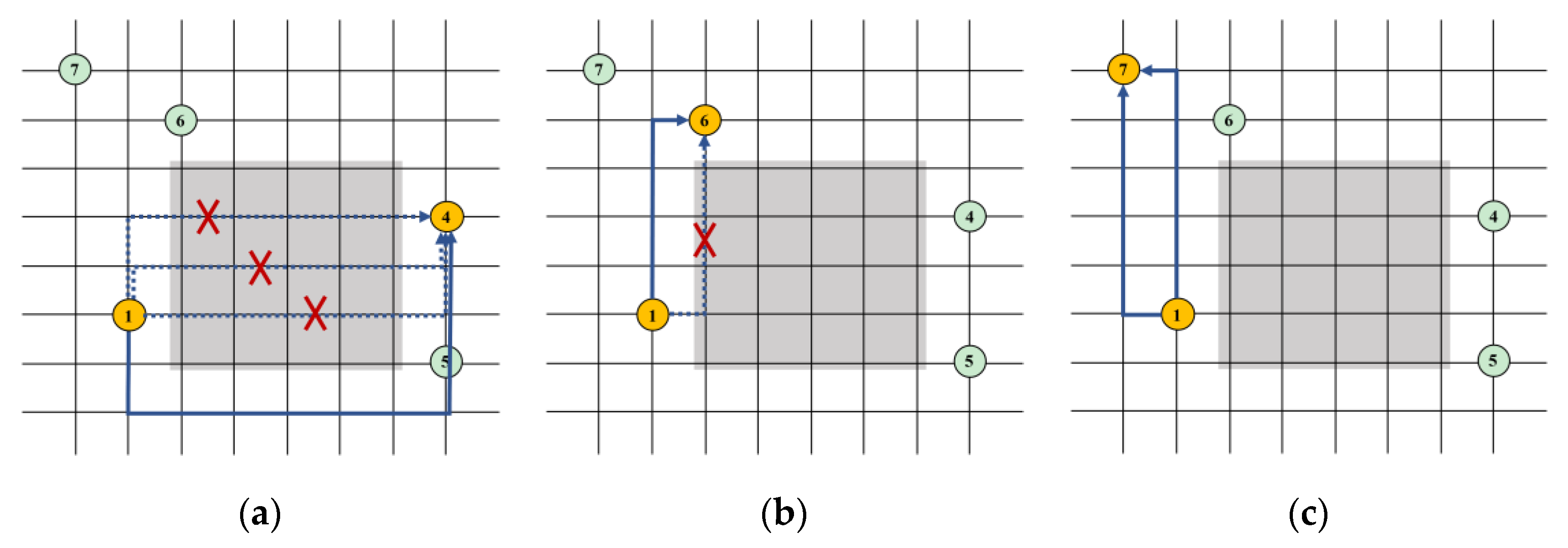
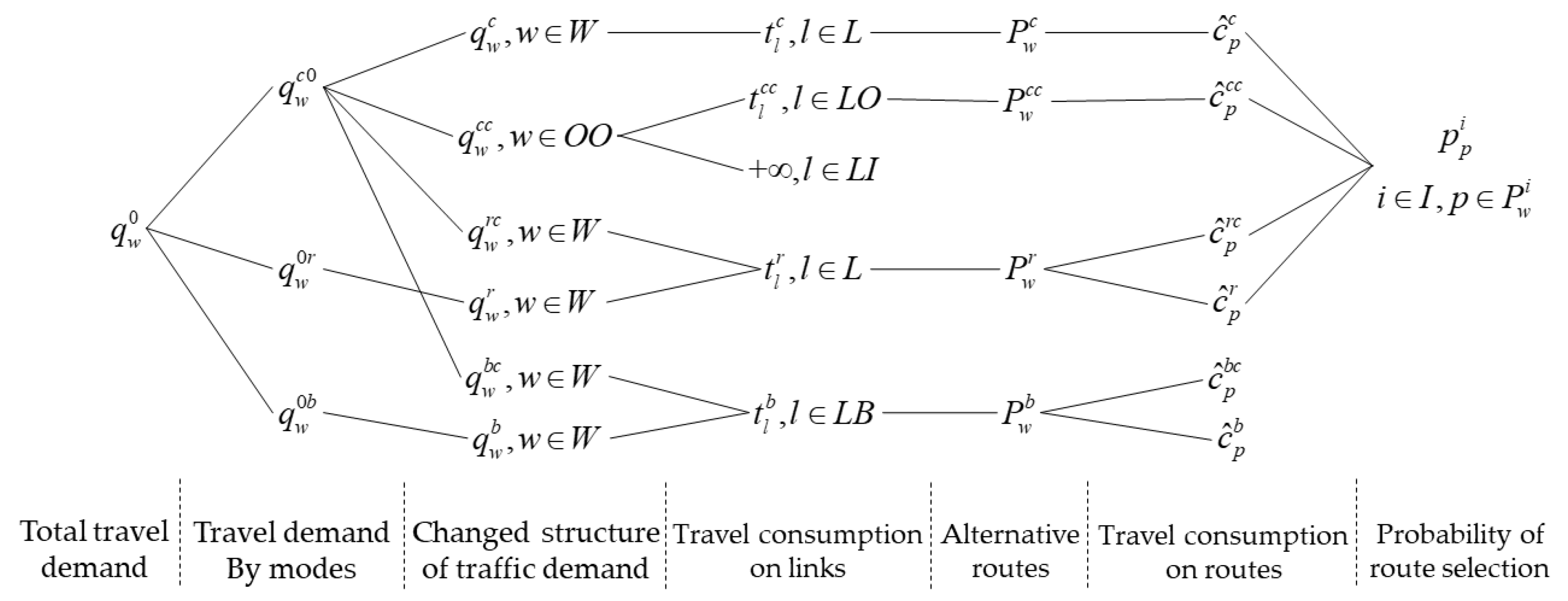

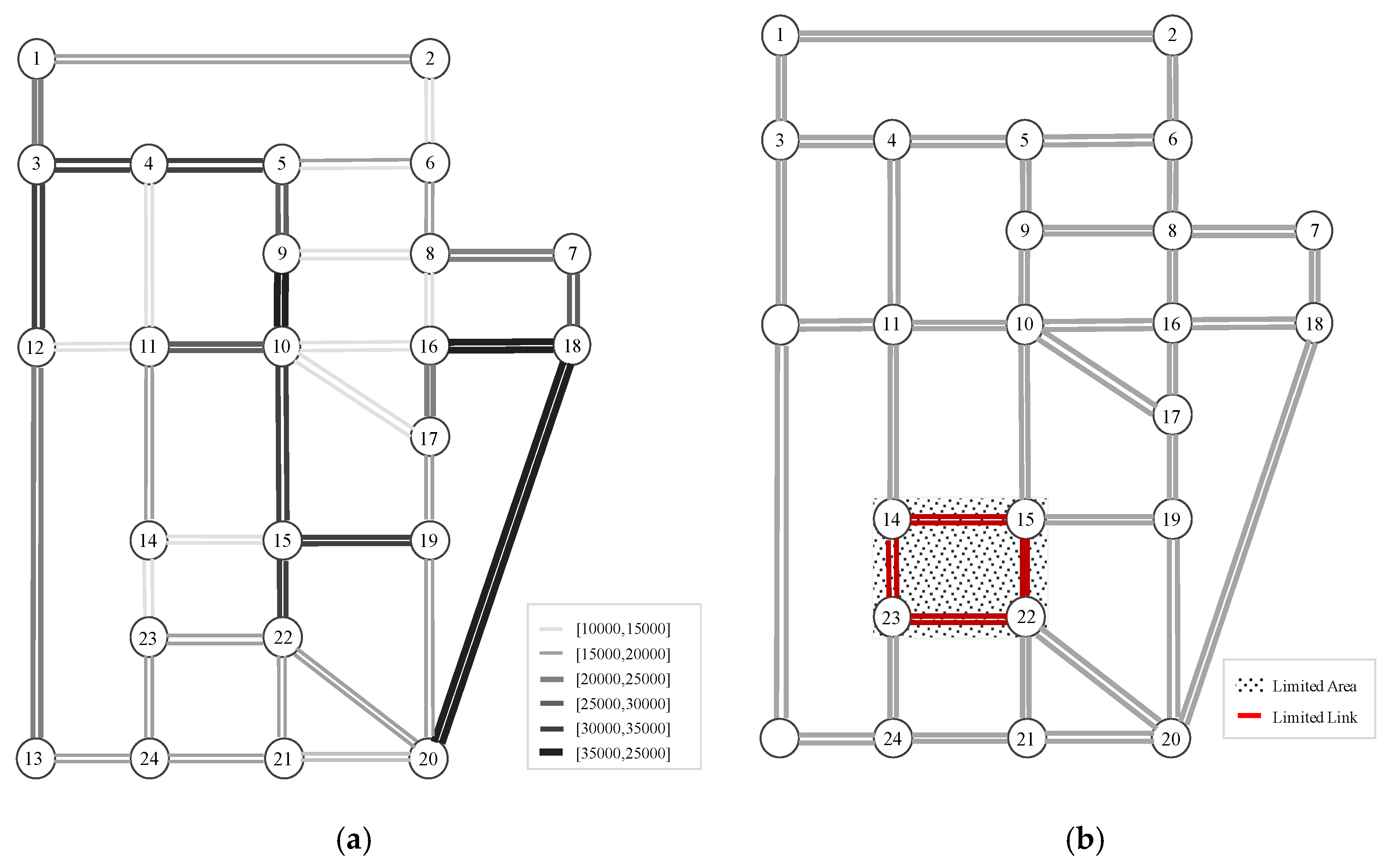

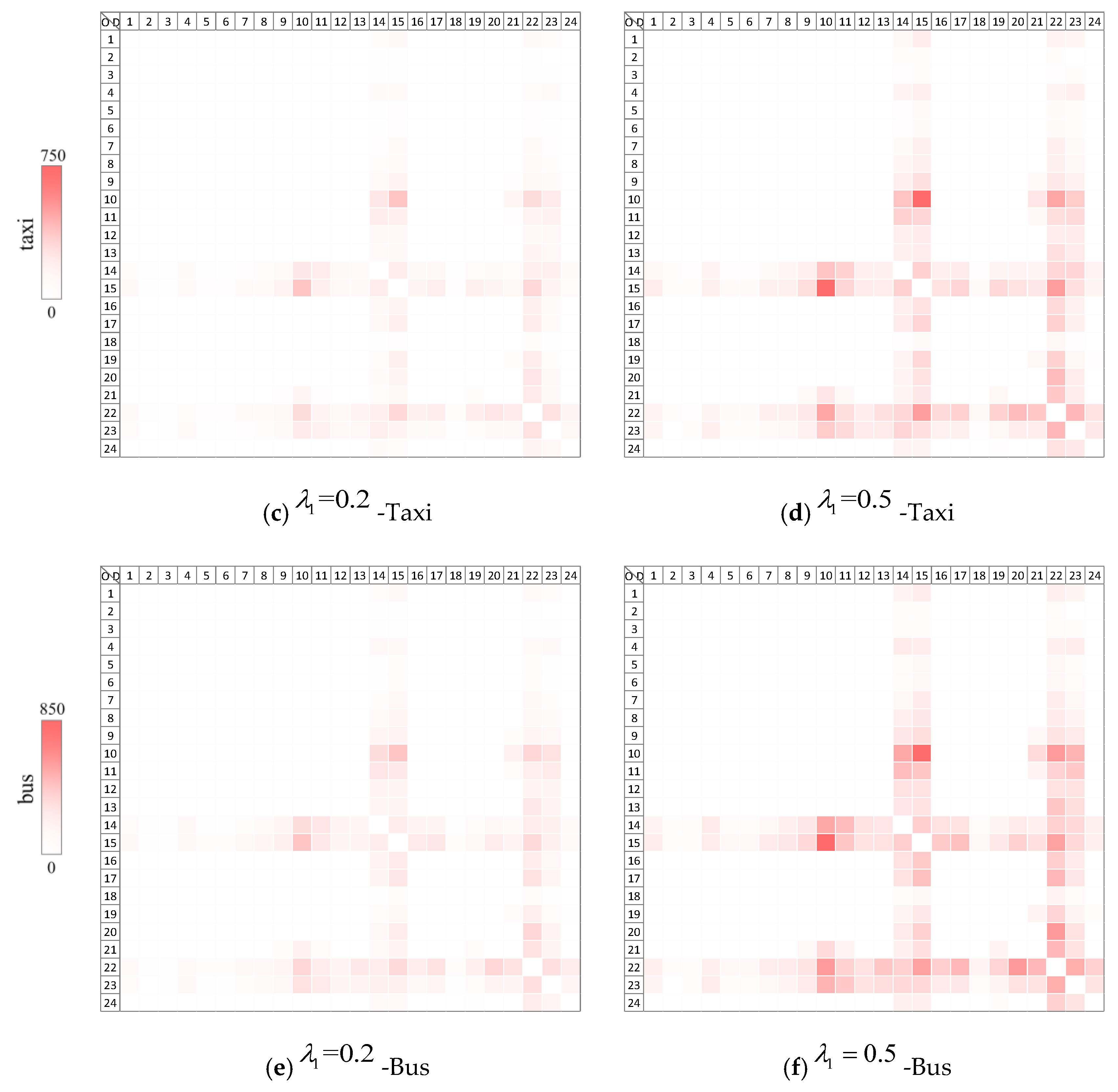

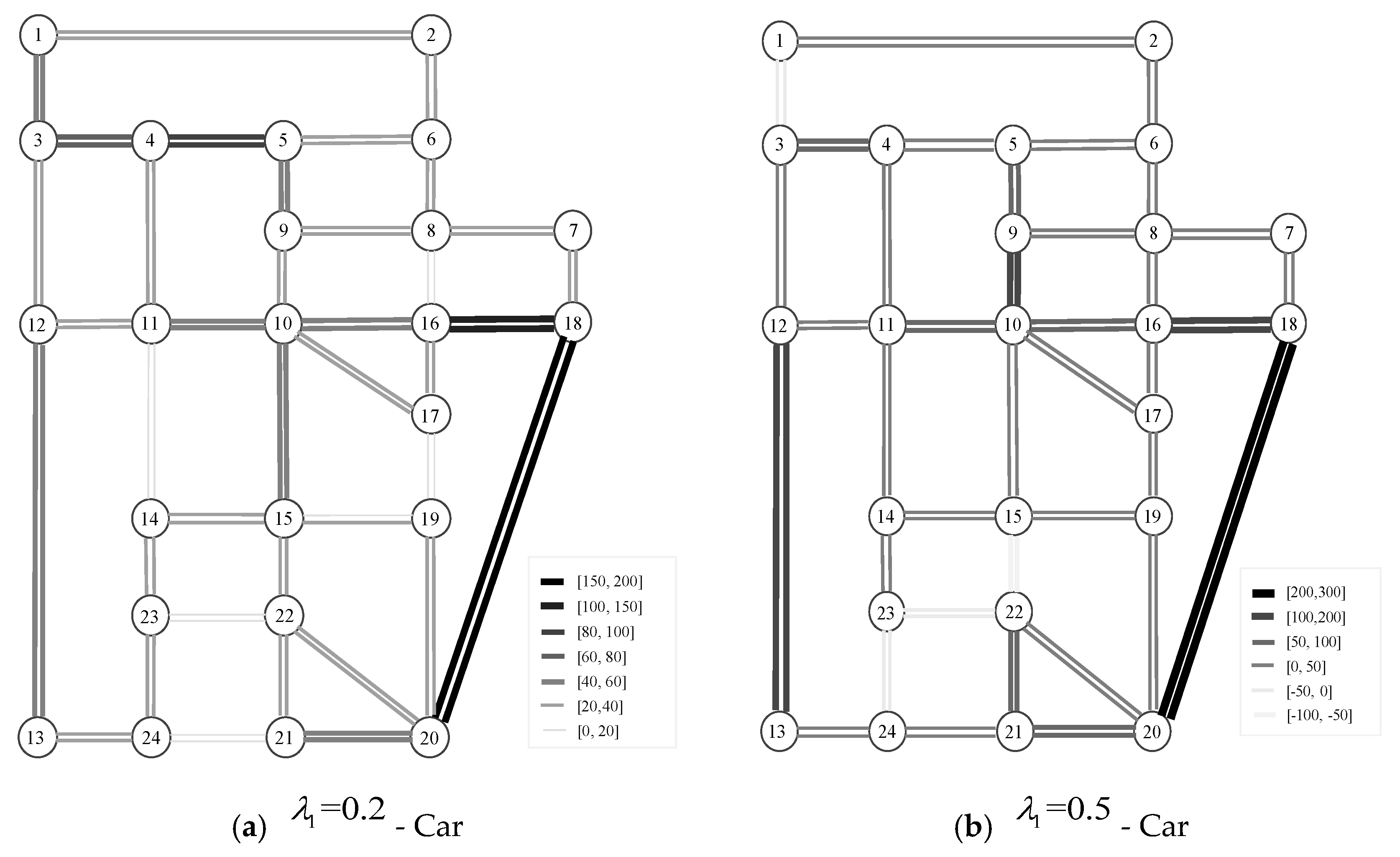


| Symbol | Definition | Additional Notes |
|---|---|---|
| A traffic mode | -- | |
| Set of traffic modes | ||
| Set of ODs whose origin and destination are both located in restricted area | ||
| Set of ODs in which one of origin and destination is located in restricted area | ||
| Set of ODs whose origin and destination are both located out of restricted area | ||
| Traffic demand of mode m before traffic restriction | ||
| Proportion of restricted private cars account for total private cars | ||
| Traffic demand of type i after traffic restriction | ||
| Set of alternative travel routes for type i traffic demand between OD w | ||
| Probability of being selected for route P | ||
| Probability of being selected for mode m to replace private car | ||
| Traffic flow generated from type i traffic demand on route P | ||
| Traffic flow generated from type i traffic demand on link l | ||
| Function for calculating travel time of mode m on link l | -- | |
| Travel time of type i traffic demand on link l | ||
| Travel time of type i traffic demand on route P | ||
| Additional time of mode m in single trip | ||
| The minimum travel time of type i traffic demand between OD w | ||
| Unit time value of travelers | ||
| Use cost of unit time for mode m | ||
| Purchase cost of private car in single trip | ||
| Travel consumption of type i traffic demand on route P | ||
| Estimated travel consumption of type i traffic demand on route P | ||
| Expected minimum travel consumption of type i traffic demand between OD w |
| Mode | Before Restriction | Reduced Demand | Increased Demand | After Restriction |
|---|---|---|---|---|
| Private Car | -- | |||
| Taxi | -- | |||
| Bus | -- |
| Type | Traffic Demand | Link Travel Time | Route Set | Route Travel Time | Estimated Travel Consumption | Probability of Route Choice |
|---|---|---|---|---|---|---|
| -- | ||||||
| -- |
| Parameter | ||||||
|---|---|---|---|---|---|---|
| Value | 50 RMB/trip | 0.4 RMB/min | 1.5 RMB/min | 0.1 RMB/min | 5 min | 10 min |
| CO2 (kg) | NOx (kg) | TEC (ton) | CO2 (kg) | NOx (kg) | TEC (ton) | |
|---|---|---|---|---|---|---|
| M0 | 79.79 | 426.63 | 28 | 79.79 | 426.63 | 28 |
| M1 | 75.81 | 405.92 | 26.6 | 70.65 | 379.03 | 24.79 |
| M2 | 75.99 | 406.83 | 26.66 | 70.87 | 380.19 | 24.87 |
| (M0-M1)/M0 | 4.98% | 4.86% | 4.98% | 11.45% | 11.16% | 11.46% |
| (M0-M2)/M0 | 4.76% | 4.64% | 4.76% | 11.17% | 10.89% | 11.17% |
| (M2-M1)/(M0-M2) | 4.56% | 4.58% | 4.56% | 2.53% | 2.49% | 2.53% |
| Routes (M1 and M2) | Detour Rate | Route Flow | |||
|---|---|---|---|---|---|
| M1 | M2 | M1 | M2 | ||
| 1 | 21-20-18-16-10 | 2.740 | 2.769 | 9.933 | 33.723 |
| 2 | 21-20-19-15-10 | 3.026 | 3.042 | 9.016 | 30.604 |
| 3 | 21-24-13-12-3-4-5-9-10 | 3.115 | 3.131 | 8.982 | 30.352 |
| 4 | 21-22-20-18-16-10 | 3.157 | 3.185 | 8.201 | 27.844 |
| 5 | 21-20-18-16-17-10 | 3.373 | 3.396 | 8.093 | 27.477 |
© 2020 by the authors. Licensee MDPI, Basel, Switzerland. This article is an open access article distributed under the terms and conditions of the Creative Commons Attribution (CC BY) license (http://creativecommons.org/licenses/by/4.0/).
Share and Cite
Wei, X.; Wang, W.; Yu, W.; Hua, X.; Xiang, Y. A Stochastic User Equilibrium Model Under Traffic Rationing Based on Mode Shifting Rate. Sustainability 2020, 12, 5433. https://doi.org/10.3390/su12135433
Wei X, Wang W, Yu W, Hua X, Xiang Y. A Stochastic User Equilibrium Model Under Traffic Rationing Based on Mode Shifting Rate. Sustainability. 2020; 12(13):5433. https://doi.org/10.3390/su12135433
Chicago/Turabian StyleWei, Xueyan, Wei Wang, Weijie Yu, Xuedong Hua, and Yun Xiang. 2020. "A Stochastic User Equilibrium Model Under Traffic Rationing Based on Mode Shifting Rate" Sustainability 12, no. 13: 5433. https://doi.org/10.3390/su12135433
APA StyleWei, X., Wang, W., Yu, W., Hua, X., & Xiang, Y. (2020). A Stochastic User Equilibrium Model Under Traffic Rationing Based on Mode Shifting Rate. Sustainability, 12(13), 5433. https://doi.org/10.3390/su12135433





